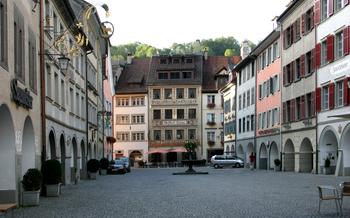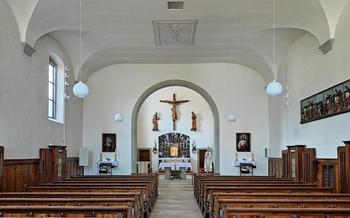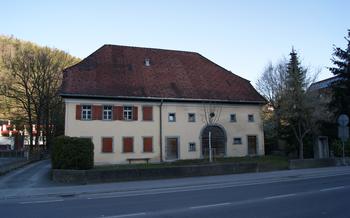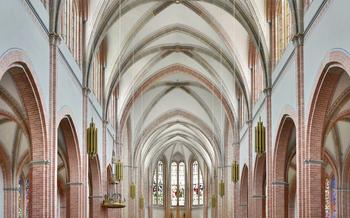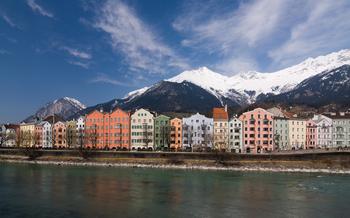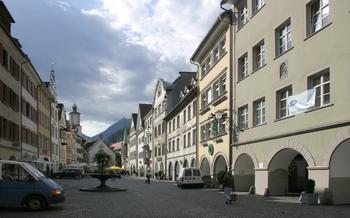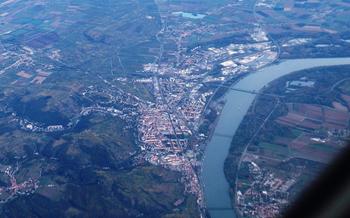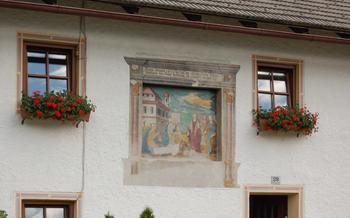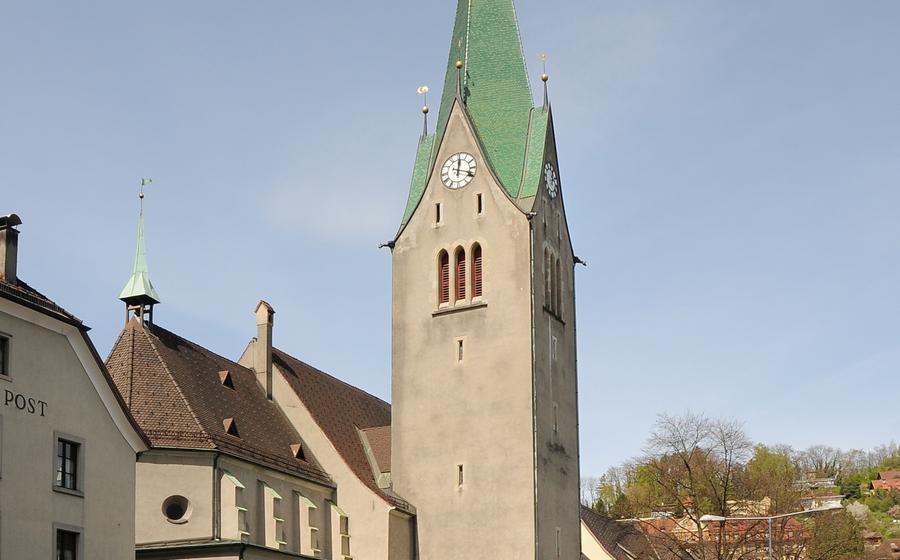
St. Nikolaus Cathedral
- St. Nikolaus Cathedral: An Architectural Masterpiece
- Unveiling the History of St. Nikolaus Cathedral
- Exploring the Cathedral's Exterior
- Stepping Inside St. Nikolaus Cathedral
- Marveling at the Gothic Architecture
- Uncovering the Stories Behind the Stained Glass Windows
- Admiring the Altars and Side Chapels
- Discovering the Crypt and Sacristy
- Attending a Mass or Service
- Taking a Guided Tour of the Cathedral
- Exploring the Cathedral Museum
- Visiting Nearby Attractions
- Tips for Photographers and History Buffs
- Insider Tip: Rooftop Views
St. Nikolaus Cathedral: An Architectural Masterpiece
In the heart of the charming Austrian town of Feldkirch, nestled amidst cobblestone streets and medieval buildings, stands the magnificent St. Nikolaus Cathedral. This architectural masterpiece, with its soaring spires and intricate Gothic details, is a testament to the town's rich history and cultural heritage. Constructed in the 13th century, the cathedral has undergone several expansions and renovations over the centuries, resulting in a harmonious blend of Romanesque and Gothic architectural styles. Its striking presence dominates the town's skyline, inviting visitors to step into a world of history, art, and spirituality.
Unveiling the History of St. Nikolaus Cathedral
St. Nikolaus Cathedral, a testament to architectural grandeur and historical significance, has stood proudly in the heart of Feldkirch for centuries. Its story begins in the 13th century when the foundation stone was laid, marking the start of a magnificent journey that would span generations. Initially conceived as a modest Romanesque structure, the cathedral underwent several expansions and modifications over time, reflecting the changing tastes and styles of successive eras.
In the 15th century, a major transformation took place, as the cathedral embraced the soaring elegance of Gothic architecture. The nave and choir were extended, and the interior was adorned with intricate vaults, graceful pillars, and stunning stained glass windows. These embellishments not only enhanced the cathedral's visual appeal but also imbued it with a sense of spiritual grandeur.
Throughout its existence, St. Nikolaus Cathedral has faced its share of challenges. Fires and natural disasters have threatened its integrity, but each time, it has risen from the ashes, restored to its former glory. The dedication and resilience of the local community have played a pivotal role in preserving this architectural masterpiece, ensuring its continued existence for future generations.
Today, St. Nikolaus Cathedral stands as a symbol of Feldkirch's rich heritage, designated as a cultural heritage site and a source of pride for the city's residents. Its enduring legacy as a place of worship, artistic expression, and historical significance continues to inspire and captivate visitors from around the world.
Exploring the Cathedral's Exterior
The exterior of St. Nikolaus Cathedral is a testament to the grandeur and artistry of Gothic architecture. The intricate carvings and sculptures that adorn the façade depict scenes from the Bible and the lives of saints, adding a layer of religious symbolism to the building's design. The towering spires and buttresses, reaching towards the sky, create a sense of awe and wonder. The main portal, with its ornate carvings and delicate tracery, invites visitors to step inside and discover the cathedral's rich interior.
Stepping Inside St. Nikolaus Cathedral
As you cross the threshold of St. Nikolaus Cathedral, prepare to be captivated by its awe-inspiring interior. The spacious nave, with its soaring vaulted ceilings, creates a sense of grandeur and invites contemplation. Light floods in through magnificent stained glass windows, casting a kaleidoscope of colors onto the polished stone floors. The intricate designs and vibrant hues of the windows tell stories from the Bible and depict historical events, adding a layer of artistic and spiritual depth to the cathedral's interior.
Elaborately carved altars and side chapels line the walls of the cathedral, each dedicated to a different saint or aspect of Christian devotion. The main altar, a masterpiece of Gothic craftsmanship, features intricate carvings depicting scenes from the life of Jesus Christ. Smaller side altars, adorned with delicate sculptures and paintings, offer a glimpse into the diverse artistic styles and themes that have shaped the cathedral's history. These chapels serve as places of worship and devotion, inviting visitors to pause and reflect on their faith.
Marveling at the Gothic Architecture
St. Nikolaus Cathedral is a stunning example of Gothic architecture, a style that emerged in Europe during the 12th century. Characterized by its pointed arches, ribbed vaults, and flying buttresses, Gothic architecture aimed to create a sense of height and grandeur, drawing the viewer's gaze towards the heavens.
The exterior of the cathedral showcases these Gothic elements prominently. The façade is adorned with intricate carvings and sculptures, depicting biblical scenes and historical events. The towering spires and buttresses not only provide structural support but also create a sense of verticality, emphasizing the cathedral's connection to the divine.
Inside, the cathedral's spacious interior is defined by its vaulted ceilings, which create a sense of vastness and awe. The intricate stained glass windows, with their vibrant colors and detailed imagery, further enhance the cathedral's ethereal atmosphere. The elaborate altars and side chapels, each with their unique artistic style and ornamentation, add to the visual splendor of the interior.
Compared to other Gothic cathedrals, St. Nikolaus Cathedral stands out for its unique blend of architectural features. While it shares similarities with other Gothic masterpieces, such as the Cologne Cathedral in Germany or the Notre-Dame Cathedral in Paris, it retains its distinct character.
Key features of Gothic design:
- Pointed arches: These arches, used throughout the cathedral's structure, create a sense of height and dynamism.
- Ribbed vaults: The ribbed vaults of the ceiling distribute the weight of the roof more efficiently, allowing for larger and more complex interior spaces.
- Flying buttresses: These external supports, connected to the walls of the cathedral by flying buttresses, provide structural stability and allow for larger windows.
- Stained glass windows: The vibrant stained glass windows depict biblical scenes and historical events, casting a colorful glow on the interior.
Uncovering the Stories Behind the Stained Glass Windows
The intricate stained glass windows of St. Nikolaus Cathedral are a testament to the artistry and craftsmanship of medieval glassworkers. Each window tells a unique story, depicting scenes from the Bible, historical events, and the lives of saints. The imagery is rich in symbolism and allegory, inviting viewers to contemplate the deeper meanings behind the scenes.
The windows were created using a variety of techniques, including painting, staining, and firing. The colors are vibrant and luminous, casting a warm glow on the cathedral's interior. Many of the windows have been restored over the years, ensuring their preservation for future generations.
One of the most striking windows depicts the crucifixion of Jesus Christ. The scene is rendered in intricate detail, with each figure expressing a range of emotions. The window serves as a powerful reminder of the sacrifice and suffering of Christ.
Another notable window depicts the life of St. Nicholas, the patron saint of the cathedral. The scenes show St. Nicholas performing miracles, helping the poor, and spreading the Christian faith. The window is a tribute to the saint's generosity and compassion.
The stained glass windows of St. Nikolaus Cathedral are a valuable artistic and historical treasure. They provide a glimpse into the beliefs and values of the medieval period and continue to inspire and awe visitors to this day.
Admiring the Altars and Side Chapels
The interior of St. Nikolaus Cathedral is adorned with a series of magnificent altars and side chapels. The main altar, located in the center of the apse, is a masterpiece of Gothic craftsmanship. Constructed in the 15th century, it features intricate carvings depicting scenes from the life of Jesus Christ and the Virgin Mary. The altar's centerpiece is a large crucifix, which is flanked by statues of saints and angels.
The cathedral also boasts several smaller side altars, each dedicated to a different saint. These altars vary in style and size, but all are exquisitely crafted and showcase the artistic talents of their creators. The Chapel of St. John the Baptist, located in the north aisle, is particularly noteworthy for its late Gothic frescoes. These vibrant paintings depict scenes from the life of John the Baptist and are considered to be among the finest examples of medieval art in Austria.
The altars and side chapels of St. Nikolaus Cathedral are not merely decorative elements. They serve as focal points for worship and devotion, providing a sacred space for visitors to connect with their faith. Whether you are a religious pilgrim or simply an admirer of fine art, these altars and chapels are sure to leave a lasting impression.
Discovering the Crypt and Sacristy
Beneath the ground level of St. Nikolaus Cathedral lies a hidden treasure—the crypt. This sacred space serves as the final resting place for important historical figures who have played significant roles in the cathedral's history and the community of Feldkirch. Visitors are granted a glimpse into the past as they descend into the dimly lit crypt, where intricate carvings adorn the walls and the air is filled with an aura of reverence.
The sacristy, located adjacent to the main altar, is another hidden gem within the cathedral. This room serves as a storage space for precious artifacts and vestments used during religious ceremonies. Visitors are allowed limited access to the sacristy, where they can marvel at the intricate embroidery, gleaming silverware, and other treasures that have been meticulously preserved over the centuries. Guided tours often include a visit to the sacristy, providing visitors with insights into the rituals and traditions of the Catholic Church.
Attending a Mass or Service
Enhance your visit to St. Nikolaus Cathedral by participating in one of the regular masses or services held within its sacred walls. Immerse yourself in the spiritual atmosphere as the community of believers gathers for worship, prayer, and reflection. Experience the resonant acoustics of the cathedral as the choir's voices soar during hymns and chants. Observe the solemn rituals and ceremonies that have been passed down through generations. Whether you are a devout Catholic or simply seeking a moment of tranquility, attending a mass or service at St. Nikolaus Cathedral offers a unique and profound experience.
Don't forget to adhere to the appropriate etiquette and dress code out of respect for the sacred nature of the occasion. Dress modestly and avoid disruptive behavior during the service. Visitors are welcome to join in the singing of hymns or simply observe the proceedings in quiet contemplation. Check the cathedral's official website or inquire at the visitor center for the exact schedule of masses and services, as they may vary depending on the time of year or special occasions. Embrace the opportunity to connect with the local community and deepen your understanding of the religious significance of this magnificent cathedral.
Taking a Guided Tour of the Cathedral
To delve deeper into the history, architecture, and significance of St. Nikolaus Cathedral, consider joining a guided tour. Knowledgeable guides bring the cathedral to life, sharing fascinating insights and stories that enhance your visit. Tours are available in different languages, catering to international visitors.
Guided tours offer exclusive access to restricted areas of the cathedral, allowing you to discover hidden gems and learn about the cathedral's intricate details. Your guide will lead you through the main nave, pointing out architectural highlights and explaining the symbolism behind the stained glass windows and altars.
To ensure a personalized experience, prior booking is recommended, especially during peak tourist seasons. Group sizes are typically small, creating an intimate atmosphere for interactive discussions and questions. Whether you are a history buff, an architecture enthusiast, or simply curious to learn more about this magnificent cathedral, a guided tour is an enriching experience that will leave a lasting impression.
Exploring the Cathedral Museum
Within the cathedral complex, a treasure trove awaits visitors—the Cathedral Museum. Dedicated to preserving and showcasing the history, art, and architecture of St. Nikolaus Cathedral, this museum offers a deeper dive into the edifice's significance. Through captivating exhibits, artifacts, and interactive displays, visitors embark on a journey through time, unraveling the stories that have shaped this sacred space.
From the intricate details of the cathedral's construction to the evolution of its architectural style, the museum provides a comprehensive narrative. Visitors can examine fragments of medieval sculptures, marvel at ancient liturgical objects, and trace the artistic influences that have graced the cathedral over the centuries.
Interactive displays engage visitors, allowing them to explore the cathedral's history through virtual tours, touchscreens, and multimedia presentations. Educational programs cater to both adults and children, fostering a deeper understanding of the cathedral's cultural and religious significance.
Whether you're a history enthusiast seeking knowledge or a curious traveler eager to discover the hidden treasures of St. Nikolaus Cathedral, the Cathedral Museum promises an enriching and enlightening experience.
Visiting Nearby Attractions
Feldkirch offers a wealth of cultural and historical attractions beyond St. Nikolaus Cathedral. Just a short walk away, visitors can explore the Schattenburg Castle, a medieval fortress perched on a hill overlooking the town. With its well-preserved fortifications, towers, and courtyards, Schattenburg offers a glimpse into the region's rich past.
Art enthusiasts should not miss Montfort House, a former aristocratic residence now transformed into an art museum. The museum showcases a diverse collection of paintings, sculptures, and decorative arts from the Middle Ages to the present day.
For those interested in local history, the Feldkirch Museum provides a comprehensive overview of the town's development from its early settlement to the modern era. The museum's exhibits feature artifacts, documents, and interactive displays that bring the town's history to life.
By combining a visit to St. Nikolaus Cathedral with these nearby attractions, visitors can immerse themselves in the cultural heritage of Feldkirch and gain a deeper appreciation for the region's rich tapestry of history and art.
Tips for Photographers and History Buffs
Photographers will find St. Nikolaus Cathedral a treasure trove of photo opportunities. The intricate carvings, towering spires, and stained glass windows provide endless subjects to capture. For the best exterior shots, position yourself across the street to capture the full grandeur of the façade. Inside, use a wide-angle lens to capture the soaring heights of the vaulted ceilings and experiment with different angles to highlight the details of the altars and side chapels.
History buffs, on the other hand, will appreciate the opportunity to explore the cathedral's rich past. Research the historical figures associated with the cathedral, such as the bishops who commissioned its construction and the artisans who crafted its intricate details. Attend special events or concerts held in the cathedral to experience its spiritual atmosphere and learn more about its ongoing role in the community.
Insider Tip: Rooftop Views
While exploring the wonders of St. Nikolaus Cathedral, don't miss the chance to ascend to its rooftop. This exclusive opportunity offers breathtaking panoramic vistas that will leave you in awe. From this vantage point, the city of Feldkirch unfolds before your eyes like a living painting, with its charming streets, historic buildings, and the majestic Alps forming a picturesque backdrop.
Access to the rooftop is limited and requires prior arrangement or participation in special events. However, the effort is well worth the reward. As you step onto the rooftop, you'll be greeted by an unobstructed 360-degree view that stretches from the cathedral's intricate spires to the distant mountain peaks.
Imagine capturing the golden hues of sunrise or sunset as they illuminate the cityscape, casting long shadows and creating a magical atmosphere. With a camera in hand, you'll have the chance to immortalize the beauty of Feldkirch from a unique perspective.
Whether you're a passionate photographer or simply seeking an unforgettable experience, the rooftop of St. Nikolaus Cathedral promises a moment of tranquility and awe-inspiring vistas. Embrace this insider tip and discover the hidden gem that awaits atop this architectural masterpiece.
